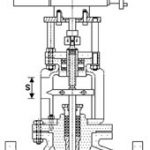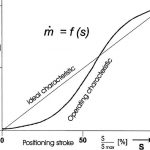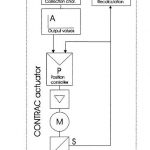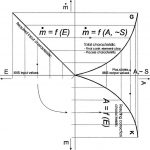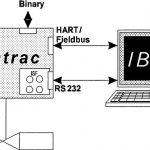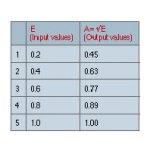Drive-specific functions, which due to their complexity formerly had to be processed in the control system, can today be processed in the drives themselves thanks to the integration of microprocessors. The linearization of control valve characteristics is one concrete example.
Joachim Gräfer
In process operations for controlling mass flows or energy supplies, linear correlations between the input and output variables are desirable for control engineering reasons. In practice, control valves and dampers (Fig. 1), which as the last elements in the control loop are responsible for the actual control task, do not have linear characteristics on account of their construction. Furthermore, there are non-linear parameters which are caused by the control system as a whole.
Valve and damper characteristics (Fig. 2) depend on the shape of the flow characteristic (cv value). Minor input changes in certain parts of the characteristic are offset by significant changes in the output variable, leading in the long run to control instabilities.
In practice, an attempt is always made to compensate the non-linear parts of the characteristic. This is achieved by adapting the design of the final control element, for example, by mechanical alterations to the cam disks and/or shafts, or by electrical adaptations to the input and output values by means of intelligent controls, such as a PLC.
Characteristic compensation
The compensation functionality of a processor-controlled system is integrated in the intelligent Contrac actuator. Together with the final control elements, this actuator system allows the input and output values to be freely assigned in a table; as a result, the characteristic can also be compensated later on without difficulty, even after project planning and commissioning. The opposite situation, in which a linear characteristic is deliberately adapted and/or “bent” for a specific application, is also possible.
The Contrac actuator system offers preselected characteristics as well as an input table for defining up to 22 characteristic points for this purpose.
The actual value is however recalculated before it is fed back to the higher control system, to permit the input and output values to be compared with one another.
In order to calculate the value table, it is necessary to know the characteristic of the final control element. Thankfully, this table has already been determined by means of measurements at a few salient operating points. The input and output values can then be assigned to one another either graphically or mathematically.
Determining the characteristic is not as simple as it first appears, however. The required compensation applies not only to the characteristic of the final control element, but also ultimately to the characteristic of the complete process.
This latter characteristic is made up of the sum of the characteristic travelled through so far plus the process and material properties accumulated up to this point (Fig. 3). To take just one example, it must always be remembered that the pressure across the final control element is also a function of the opening angle. The pressure is thus variable. This naturally also has an influence on the mass flow, etc.
Practical calculation
These complex correlations do not need to be taken into account in the following calculation example, however. The overall characteristic shown here can be described by means of the quadratic function (1) for a defined curve segment.
dm/dt = f (A) = (A – C1 )² + C2 (1)
The shape of the required input characteristic is basically arbitrary. As explained above, it is represented in the following example (Fig. 4) by a straight line with function (2):
dm/dt = f (E) = E · m + C3 (2)
The following correlations are obtained when the correction characteristic necessary to achieve the required linear behaviour is determined:
dm/dt = (A – C1)² + C2 (1a)
dm/dt = E · m + C3 (2a)
If (1a) is equated with (2a), then:
(A – C1)² + C2 = E · m + C3 (3)
If C1 = C2 = 0 (quadratic function passing through the origin), C3 = 0 (straight line passing through the origin) and m = 1, the results of equation (3) are as follows:
A² = E (4)
A = Ï E (5)
The value table for a correction characteristic is obtained at five points (up to 22 different points can be defined by the user in Contrac). This means that the shape of the correction characteristic corresponds to a mirrored function of the overall characteristic G (referred to the coordinate axis A), as is to be expected in view of the required linear input behaviour (see Figure 4, function K).
If the required input characteristic is not linear, the graphical representation of the resulting correction characteristic (Fig. 4) does not correspond to the mirror image of the overall characteristic.
Characteristic correction function
The characteristic correction function of the Contrac variable-speed drives can be activated and parameterized using IBIS/Smart Vision. IBIS/Smart Vision, an intelligent information and broadcasting system, is a graphical software program based on a window technique. It can be operated by means of either a mouse or the keyboard, and is used for digital communication with intelligent field instruments.
This user interface, which is integrated in the “IBIS/Smart Vision for Contrac” applica-tion, enables any drive-specific functions and information to be made available to the operator. IBIS/Smart Vision can be used, for example, to specify the configuration, set parameters and operate, interrogate and test the actuator. The dialog between IBIS/Smart Vision and the intelligent, communication-capable Contrac variable-speed drives can take place via the RS 232 interface, the HART standard or a field bus connection (Fig. 5).
The installation program allows IBIS/Smart Vision to be installed in various languages. It is also possible to select the communication interface and to protect access to certain functions by means of passwords.
An existing connection to the drive is not required in order to prepare the drive configuration and parameters. Offline configuration and parameterization are possible in the office thanks to an internal database. The settings can then be copied to the appropriate drives later on. Each configuration step is subjected to a plausibility check. It is also possible to save the calculated actuator parameters on disk and use them for other drives with identical functions.
The characteristic correction function is activated in the window for selecting and configuring actuator-specific functions (Fig. 6). In addition to selecting a linear characteristic shape or a freely definable characteristic, it is also possible to select equal-percentage characteristics, for example.
“Equal percentage” means that a change in the stroke results in an equal-percentage change in the corresponding cv value.
It is possible to archive up to 22 characteristic points in a view that can be activated in the characteristic selection window.
Elsag Bailey/Hartmann & Braun
Fax: ++49/571/830-18 60
Further information cpp 202
References
[1] Gräfer, J.; Kühn, F.: Contrac, Intelligent Modulating Actuators, Today – Prepared for the Future; Hartmann & Braun Special Documentation A586549, 11.95
[2] Gräfer, J.; Kühn, F.: Intelligent Electric Actuators for Process Automation; Industrial Armatures, Number 3, September 1996, Vulkan Publishers, Essen
[3] Hart Communication Foundation, Austin/Texas: HART Field Bus Communication Protocol, Introduction for Users and Manufacturers
[4] Profibus User Organization, Karl-sruhe: Profibus, Technical Pamphlet
[5] VDI/VDE-GMA, Düsseldorf: VDI/VDE Guideline 2187
Unsere Webinar-Empfehlung
Der Webcast MTP und modulare Produktion bietet eine einzigartige Gelegenheit, mehr über die aktuellen Entwicklungen bei MTP und in der modularen Produktion zu erfahren.
Chemie- und Pharmaproduktion braucht mehr Flexibilität
In der heutigen sich schnell wandelnden Welt stehen…
Teilen:



